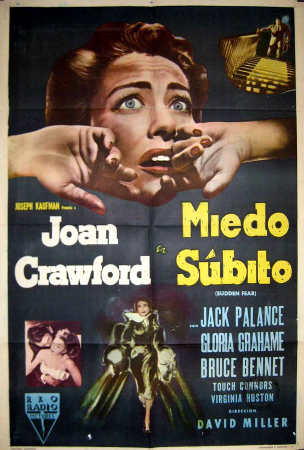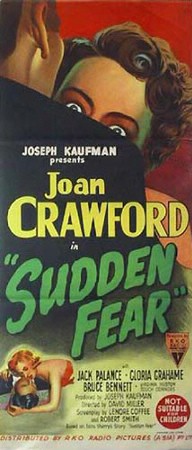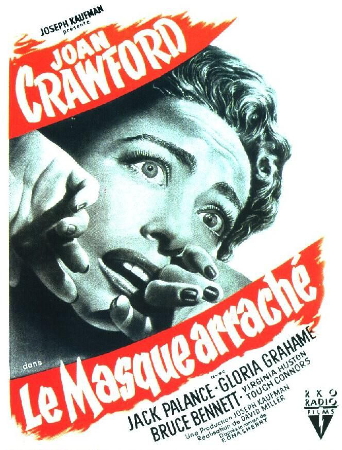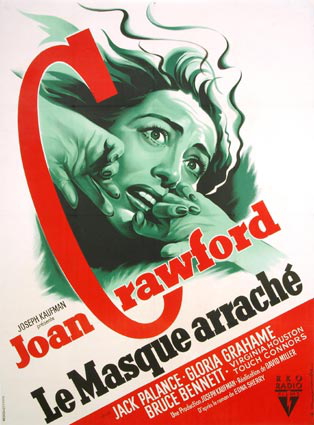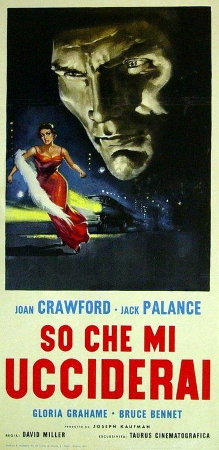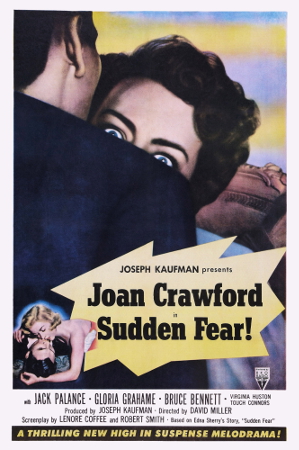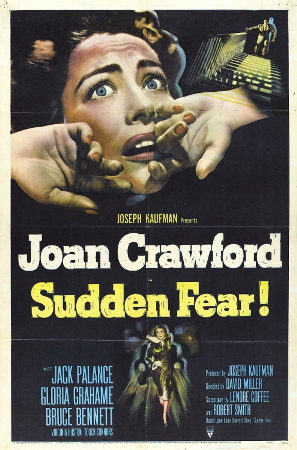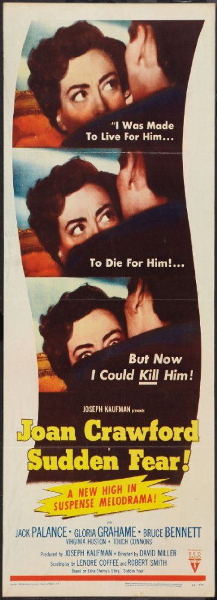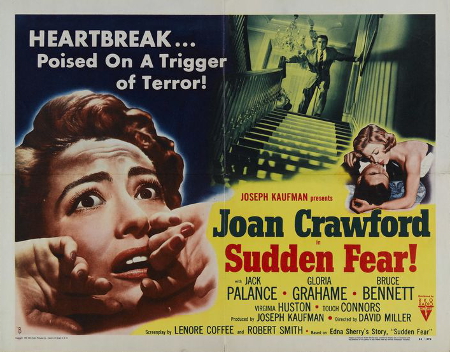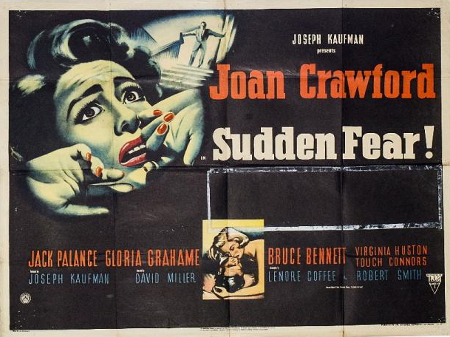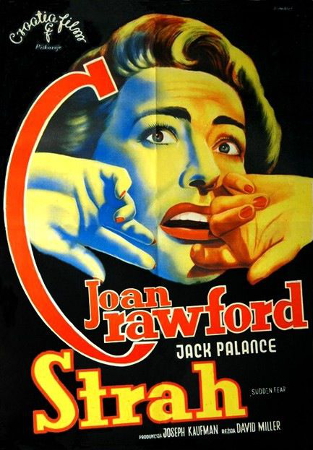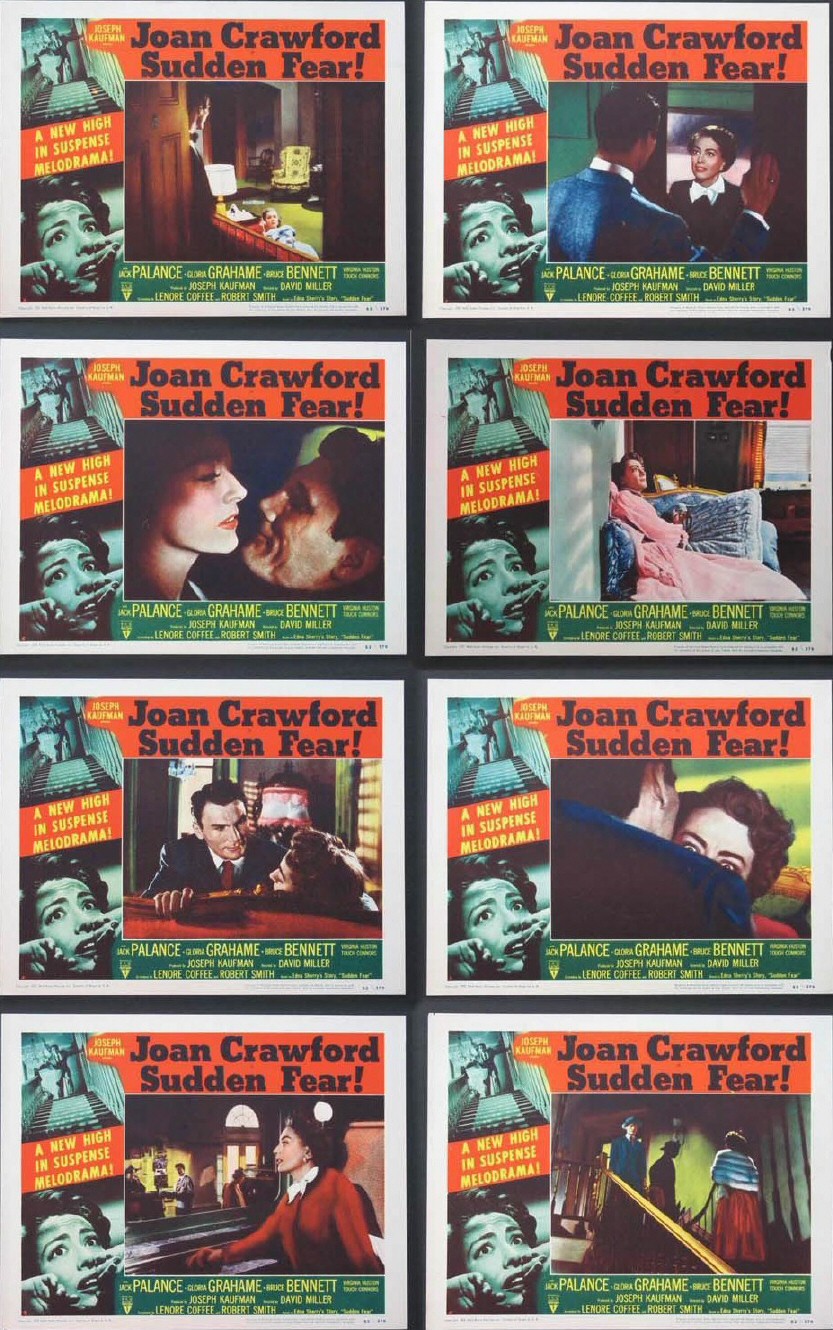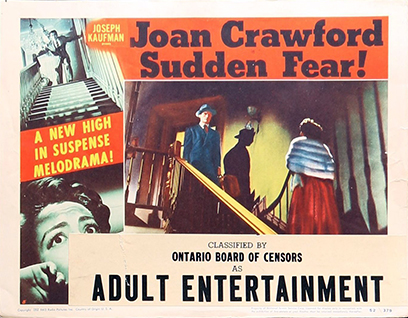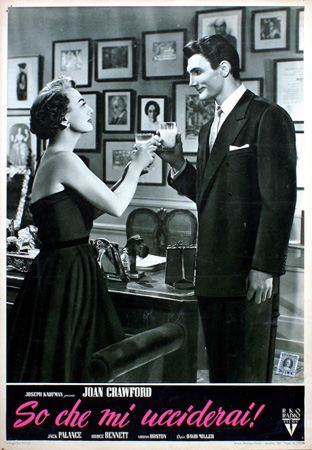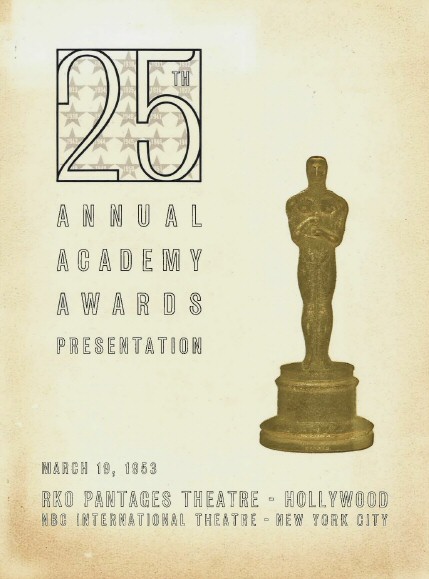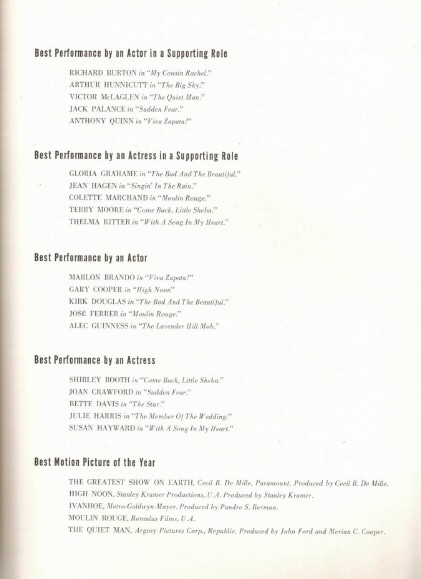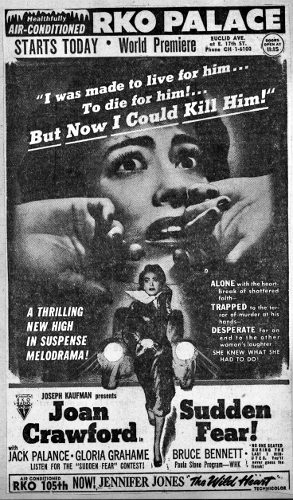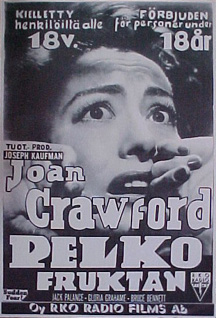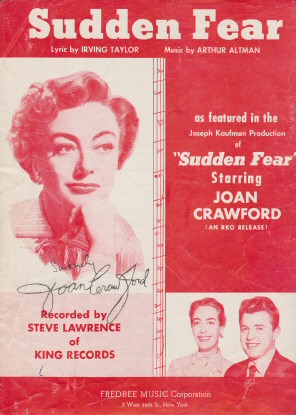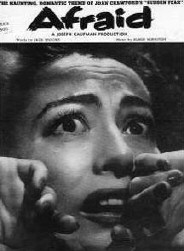|
 Tom C. (November 2024) Tom C. (November 2024)
Rating:     of 5 of 5
In
my Hollywood alternate universe I envisage Norma Desmond---graduate of
the “faces > voices” school of acting---sitting in her padded cell
enjoying the heck out of Joan's performance as Myra in Sudden Fear (1952). As mentioned in several reviews, Joan’s face is the star of this movie. I like to think today in SF Joan
took the acting skills she worked hard to master in talkies, and
embellished them with the expressive facial mannerisms of her silent
films.
This is best exemplified by two notable scenes: the first in which she
discovers the recording that reveals her husband’s duplicity, and the
“closet” scene. One scene that does not get enough recognition is the
scene that follows the former. Joan locks herself in her bedroom trying
to process the turn of events. She eyes the pillow that still bears the
imprint of her husband’s head from the night before. Since 1950s
Hollywood required husband and wife to sleep in separate beds, the
subtle implication is that there had been sexy time the night before.
Spying the dented pillow, Joan throws it off the bed, marking a symbolic
end to her connubial bliss. The fear and angst that plays across her
face while requisite film noir shadows encroach is a masterpiece.
This
is also where the movie really takes off for me. With the recording
disc broken, Myra can’t go to the police and have her tormentors thrown
in jail. Joan puts a quick end to her simpering and concocts a plan to
take out hubby Lester and his paramour Irene. This is my Joanie! This is
Rene Contrecoeur (Winners of the Wilderness, 1927) who refuses to bow to threats of an armed spy, this is Sadie Thompson in Rain (1932) damning Reverend Thompson to Hell, this is Anna Holm (A Woman's Face, 1931) slapping the heck out of Vera Segert. Joan the fighter brings this movie alive for me.
Adding to the silent film vibe of Sudden Fear is the sound track by Elmer Bernstein. Having seen Sudden Fear a
few times now, it's fun to ignore the dialogue a bit and invest a few
brain cells into what Maestro Bernstein is doing to add mood to the
proceedings.
Joan
is well supported by her two costars. Lester is played by Jack Palance
in one of his first movies. Gloria Grahame (who played Bedford Falls
flirt Violet Bick in It's a Wonderful Life,
1956) is Irene. They're clichéd film noir characters, but both do very
well in their roles. Palance would gain an Oscar nomination, as did
Joan, for SF.
My only issue with Sudden Fear is
that it's 30 minutes too long for my taste. The first half hour
focusing on the courtship and marriage of Myra and Lester could have
been condensed. However, that's a minor quibble; once the action gets
going and Joan dries her eyes, the time just flies.
 Stuart Hoggan (September 2013) Stuart Hoggan (September 2013)
Rating:     of 5 of 5
Sudden Fear is
one of the more stylish surprises in Joan Crawford’s catalogue. Relishing the
melodramatic formula of her acting style and infusing it with the taut narrative
structure of a hard-boiled thriller, it also afforded Crawford her final Oscar
nomination. Here, though, she also took a credit as producer.
Boasting some expertly executed scenes, creative lighting
effects, suspense and charismatic performances, Sudden Fear was an
unexpected return to form for the dejected Warners star.
When wealthy playwright Myra
Hudson (Crawford) turns down Lester Blane (Jack Palance) as a prospective
leading man for her new script, he later manages to seduce his way into her
heart and, after a whirlwind romance, marries her. Unfortunately, sinister
intentions belie Lester’s affection as he and his scheming mistress Irene
(Gloria Grahame) hatch a terrible plot to murder Myra and inherit her money --
but in a crucial moment of error, they are unwittingly found out. Sudden
Fear ultimately focusses on a spurned Myra’s campaign for
revenge.
Unsurprisingly, the film belongs to La Crawford and her one
skillful scene of histrionics. When her happiness is utterly shattered by the
discovery of her husband’s deception, Crawford serves a set text of how to emote
using only the face; her eyes glide over heartbreak, revulsion and panic with
quivering ease. Later, in a forced embrace with Lester, she ambiguously mumbles
to her husband, “I was wondering what I’d done to deserve you” before dissolving
into sheer disgust as she walks away. But there’s also a strong moral core to
Myra’s own devious rebuttal and therein also lies the complexity of Crawford’s
performance.
Sudden Fear bolsters its leading grand dame with two
key supporting players in Jack Palance and Gloria Grahame. Truthfully, Palance
generates more natural chemistry with Grahame and together their scenes crackle
with delicious villainy. Grahame in particular adorns an unwavering sense of
smugness as the conniving femme fatale; it’s a pity that she and Crawford share
so little scenes together.
Suspense is woven masterfully with superlative
shadow and light effects as the vice closes in during the cat-and-mouse games
between Myra and Lester: the tense mood bubbles nicely, especially when a windup
toy threatens to expose Myra’s presence in an apartment she has snuck into. The
film also redeems itself from a seemingly predictable narrative twist with a
highly dramatic conclusion.
Sudden Fear was the birth of another
experimentation period in Joan Crawford’s choice of material. It would be over
another decade, however, that she would follow the success of this definitive
woman-in-distress phase when she united with archenemy Bette Davis to star in
the popular What Ever Happened to Baby
Jane?
 Ricoh
Vigen (June 2013) Ricoh
Vigen (June 2013)
Rating:      of
5 of
5
The story is a
little far-fetched, but there is plenty of gripping drama and tension
to really keep you interested from start to finish. Oscar-worthy for
sure. A white scarf billowing as Joan runs up and down the streets of
San Francisco with sweat pouring down her face; the wind-up dog
walking to the closet where Joan hides, threatening to reveal her; an
accidentally recorded conversation revealing a murder plan: all are
elements that make this movie, in my opinion, Joan's most thrilling
and darkest film noir.
Sheila
Hall (September 2010)
I was not enthusiastic about seeing Sudden Fear. After all, our world has changed a lot in the fifty-eight years since this film was made. We have computer imaging, sound enhancement, unbelievable photography, film schools, arcane methods of film distortion. And probably much more that any of us realize.
I am a great fan of fast action, quick resolution. Car chases are one of my favorites. But, in achieving all of these, one very important characteristic is lost: CHARACTER DEVELOPMENT. The camera work in Sudden Fear does much to bring about the sudden fear in Joan Crawford's character Myra Hudson. The wide, relaxed shots of rehearsals in the New York theatre, the comfortable rocking sensation on the train ride to California, the party scenes all are instrumental in relaxing the viewer and enabling him
or her to really feel the impact of fear as Myra Hudson finds a recording made of a plot hatching between Lester Blaine (admirably portrayed by Jack Palance) and Irene (played by Gloria Grahame).
And, while the tempo is slower than we expect today, the result is a terrifying catapult into the denouement -- every bit as terrifying as any Hitchcock film. It is aptly named, beautifully executed, and scary as all get-out!
 Michael Lia (February 2010) Michael Lia (February 2010)
Rating:      of
5 of
5
Ladies and Gentlemen:
Miss Joan Crawford is now a freelance actress!
It
did not mean much to be queen of the Warners lot the last few years.
If she had to struggle, why not struggle on her own! With time, place,
and circumstance all perfectly aligned, Miss Crawford, with trepidation
and a bit of magic, forges ahead and begins her 20-year freelance
career. She embraced television along the way and gave herself more
challenges. (I think of those lucky people sitting at home in the 50s,
and Miss Joan Crawford appears in their living rooms -- just as good as
seeing Bette Davis or the Duke. Wow!)
Miss Crawford was defiantly not going to disappear, and with Pepsi-Cola on the horizon, she would soon
be everywhere!
This film challenged and elevated Miss Crawford and she elevated the audience! Sudden Fear
is a good, crisp, clean thriller and is expertly cast and directed. The
opening credits are good, with the musical score from the great Elmer Bernstein
-- he takes you right in and gets the heart beating and keeps it beating!
Miss Crawford is generally excellent throughout. She gives us an intense night in the theatre.
Her
emotions fit the story and script perfectly, and her performance at this
point in her career isn’t just showing off but damn good acting. I do not find much fault with this film because I can always count on it, and Miss Crawford provides me with a thrilling evening.
Mr. Kaufman produces with the star in mind and the new way of doing business in Hollywood
for a studio gal like Miss Crawford. This was big stuff, and Mr. Kaufman
does everyone involved a favor by being a complete professional. Just
wish he had more stories for Miss Crawford.
Miss
Crawford herself was already behaving like a producer, as she was very
concerned about the budget and hired director David Miller, a former
film cutter from her MGM days. I think he and the cameraman and the
editor captured some fine moments and held some scenes for quite
some time and in other parts wasted no time; all which is hard to do -- the
cuts are top notch.
A
closet, a gun, a car chase, a child's toy, a ticking clock, a key, a
bottle of poison, a birthday party , a scarf -- all of these things are
characters in the story. Hitchcock would have had fun with this one!
Mr. Miller gives the audience some panic-stricken moments of pure
terror and suspense, and it all blends well.
Miss
Crawford's acting ran a gamut, that is for sure. She is loving, waiting,
sweating, running, hiding, thinking, and then there is a beautiful fade-out of Miss Crawford walking up a hill and going home and walking right
into the camera. It is actually touching, and something of her spirit
comes through with that fade-out. I love it!
Her
face is magnificent. Her face upstages herself! It should get co-billing. Miss Crawford holds your interest and the freelance world
takes notice. Sudden Fear receives four Oscar nominations. (Miss
Crawford receives her third nomination for Best Actress for this film.)
When
all the elements are there, or most of them anyway, it is hard to miss.
(I think Miss Crawford said that at one point and it is true.)
Supporting Miss Crawford is the fresh Method actor Jack Palance.
He is one rough dude, and despite all the rumors over his being cast, I
think he made the role his own. He gives it the charm and sleaze
that is standard in most bad men, and you believe he could be a killer
and a thief and a two-timing no-good louse. The cameraman (an expert)
had a hard time photographing Mr. Palance, and in the early scenes he
looks a bit different. I saw this film at the Castro theatre in San
Francisco and people laughed a little (which they will do at older
films), and on the way out I heard a few people talking about how bad
Mr. Palance and Miss Crawford looked. I was a bit mortified and I can
see it now, but I think the camera work is a bit magical and adds some
depth to the film process and the menacing script. Palance earned his
Supporting Actor nomination and I was happy to see Miss Crawford’s film
get the big Hollywood recognition.
Ladies
like Miss Crawford are horrified; ladies like Gloria Graham are
intrigued and in love with the rat men. Gloria Graham is some of the
best support Miss Crawford was going to get in the remaining decades.
She makes her role the essence and epitome of lazy, evil trash-girl on
the make, and wanting some cash to retire and live happily ever after!
She makes the film wide awake when she walks in the room, and somehow
things will not be the same! Miss Graham is wonderful and she won an Oscar for The Bold and the Beautiful, filmed and released the same year, and also starred
in The Greatest Show on Earth. However, for me, Sudden Fear remains her best performance and defiantly Oscar-worthy.
The other supporting cast members are strong and consistent: Bruce Bennett from, yes, Mildred Pierce has a few good moments of acting with his eyes.
Virginia Huston of Flamingo Road is the perfect secretary; I bet she had more scenes and they were cut, because she just disappears. I like her persona.
Mike Connors (of TV’s Mannix)
handles his role with some ease and plays well. It could have been
anybody in his part, but it was him and I think his acting is very
confident.
Sudden Fear is something Miss Crawford should be proud of. My only sadness is that, besides Baby Jane,
she was never going to recapture or surprise us with one more good
worthy role and mark her 50th year in show business in 1975 with an
Emmy-worthy role or a very rare motion picture role deserving of her
talents.
My
other reason for loving this film: As a San Franciscan, I love seeing
the city in its 50s glory. I know every spot where the actors appear, and every
building. It is very nostalgic for me; I even worked in the house on
Scott Street (catering), and I just crack up that Jack Palance lives at
the bottom of the “crookedest street," which is now a complete tourist
venue.
Other
than a horrible nightgown that one reviewer wrote about (I totally
agree, it is awful), costumer Miss O’Brien remains a question mark for me because
of that thing. However, Miss Crawford looked very appealing and
glamorous and classy, with the right amount of sex appeal that worked
with the script.
Sudden Fear was a great moment in Miss Crawford’s career and our cinema. It is a wonderful film. Go see
(rent) it tonight!
John
Finley (February 2007)
I had
nothing to do yesterday, so I went to the library. I’d never even thought
to look at their DVD collection, because I always thought it’d be drab. I
was sorely mistaken! Lo and behold, Sudden Fear was there and I
just had to check it out! The movie was so wonderful that I watched it twice!
Joan’s
acting was superb throughout Sudden Fear, with the exception of two scenes
(that I noticed). These two scenes were a little over the top, even for Joan.
The first scene was when Myra found out Lester was plotting against her. All of her eye movement
and shaking hands were a little bit unreal in a sense that it was a style
probably used in the Silent Era, when there was no sound to dictate what the character
was feeling. The final over the top scene was the last one, in which Lester
mistakes his accomplice for Myra and runs her over. I can understand Myra’s silence, but not
for as long as she held it, eventually leading to her long walk back up the
hill. My favorite scene was the ubiquitous scene Joan liked. This was the scene
in which Myra had to hide in the closet when Lester came into the apartment
unexpectedly.
Sudden
Fear was put together very well, and of course Joan was well dressed throughout
the entire picture, with the exception of that ugly Johnny Guitar-esque nightgown she had on in a couple of scenes. The set designers did a great job
putting together everything, including the 1952 Packard Patrician 400 Myra
drove around, and the 1952 Packard convertible Lester drove. Back then, those
were haughtier to own than a new Cadillac. The cast was also well put together
with the exception of Jack Palance. His character in the movie paralleled him
in real life. Both actors were great performers, but weren’t just right
for the part of Lester Blaine. Palance’s features were just a little too
harsh, even for the part of Lester. However, most later Joan Crawford vehicles had
B-Movie men, instead of the Gables and Hudsons of that time period. However, it
was a great surprise to see Bert Pierce (from Mildred fame) in Sudden
Fear.
Sudden
Fear was a great movie to watch, and I’d recommend it to any "Noir” aficionado or Joan Crawford fan.
 Stephanie
Jones (January 2005) Stephanie
Jones (January 2005)
Rating:
    of 5
of 5
Sudden
Fear, for all of its "classic noir" reputation, can
for me best be described as an homage to Joan Crawford's face. Aside
from 1932's Rain and 1946's Humoresque, I can't think of another
Crawford film that relies more heavily on Joan's facial expressiveness to propel the picture.
Some harsh lighting here often reveals every one of her nearly-50 years, but
what her face has lost in dewy youthfulness it has gained in character and its
sheer ability to compel.
In
Fear, Joan plays Myra Hudson, a San Francisco heiress and playwright
who rejects odd-looking actor Lester Blaine (Jack Palance) as the romantic
lead in her latest play, then later, by chance, encounters him on a train
and falls in love with him.
The
first half-hour of the film is rather pedestrian: Myra and Lester court, then
get married, then enjoy a few screen minutes of nuptial bliss. All seems cosy...until
smirking sexpot Irene (Gloria Grahame) shows up. Irene and Lester were once
hot-n-heavy lovers as well as partners in petty crime back East; they quickly
resume their affair and then begin to plot to get their greedy hands on Myra's
money. Myra remains blissfully unaware of their trysts and eeevil plans...until she's in her study and discovers that her dictation machine was
accidentally left on overnight. Myra hears a recording of Lester and Irene expressing
their eagerness both for each other and for the idea of offing Myra in the next
3 days---before her proposed will changes go into effect.
At
this point the film really kicks in, both plot- and acting-wise, and from here
on, the camera begins intensely lavishing its attention on every nuance of Myra's
reactions to the betrayal she's discovered.
The
scene where Myra first listens to the recording and discovers Lester's perfidy
is both fascinating and painful to watch because we're given no respite from
the emotions that Myra's experiencing. Whole minutes go by in silence as we
see Myra, often in close-up, reacting first in disbelief, then confusion,
then sadness, then literal nausea, as she finally runs to the bathroom to throw
up. The pure acting ability, and acting bravery, required to pull off
such an uncomfortable scene is enormous, and I've never seen anything quite
like it. Ever. Even in silent films, where similarly claustrophobic camera attention was necessarily
paid to the actors' every expression.
Joan's
acting skills are also evident in an earlier scene, when Lester hasn't
shown up for a party in his honor and Myra goes to his apartment to find him---her
awkwardly smiling look of utter love and submission and fear of rejection as
she climbs the stairs and says to him "Without you I have nothing"
is intimately and painfully nuanced.
Similarly
interesting acting-wise is a scene between Myra and Lester after she has discovered
his plot and has lain awake all night planning her inventive revenge. (She is,
after all, a playwright, and wouldn't be content to merely call the police and
have Lester escorted from her home!) In this scene, Myra accidentally awakens
Lester; in their mutual surprise, neither intially has time to put on a "game
face." Watching the two skilled actors maneuver through the duplicitous,
lovingly inane "good morning" conversation is fascinating, culminating
with Lester's "Aren't you going to kiss me?" Myra complies, her still-existing
feelings for her husband battling with her repulsion for what she now knows
about him. "I was just wondering what I'd done to deserve you, " she
smiles and purrs. Then, as she turns and walks toward the camera,
away from Lester's view, her smile fades oh-so-briefly into regret for what
she's lost, then slowly transforms into grim disgust and equally grim determination
to exact her revenge. It's a classic moment in the Crawford Canon, as well as
a classic moment in film.
Joan
was nominated for her third, and final, Oscar for Sudden Fear, and it's
a well-deserved acknowledgment of her acting talents. Fear has often
been cited for its stylish noir qualities, and indeed there are plenty of shadows as well as much angst-ridden psychological plot tension. What makes
the film ultimately so memorable, though, is not necessarily the plot (which can occasionally
seem implausible) nor the camera tricks (which, especially in the fantasy sequence,
can seem dated today), but
rather director David Miller's utter trust in the ability of Joan Crawford's
face and acting to carry the show.
|


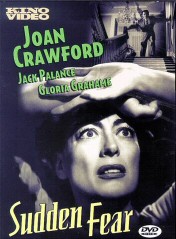
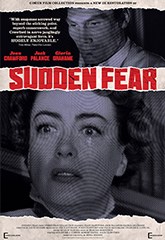


 Ricoh
Vigen (June 2013)
Ricoh
Vigen (June 2013) Michael Lia (February 2010)
Michael Lia (February 2010) Stephanie
Jones
Stephanie
Jones 